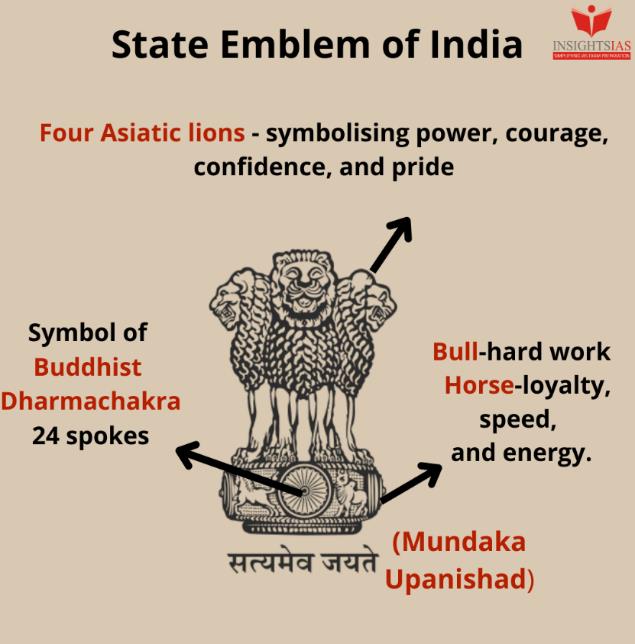National Emblem
Context: The Prime Minister of India unveiled the 6.5 metre-tall National Emblem on top of the under-construction new Parliament building recently. 
About National Emblem National Emblem
- By definition, an emblem is “a heraldic device or symbolic object as a distinctive badge of a nation, institution, or family.”
- The State Emblem of India is the national emblem of the Republic of India and is used by the union government, many state governments, and other government agencies.
- National Emblem of India is a representative seal of the Republic of India that is adapted from the Lion Capital of Ashoka Pillar (based in Sarnath, Uttar Pradesh.)
- India adopted it as the State Emblem on 26th January 1950 by Madhav Sawhney.
- The motto of the Indian National Emblem is ‘Satyamev Jayate’ or ‘Truth Alone Triumphs.’
- National Emblem is the symbol of authority and is present in all the official communications of the government.
- According to rules, the National Emblem of India can only be used as per provisions of the State Emblem of India (Prohibition of Improper Use) Act-2005 and any unauthorized use is punishable under law.
National Emblem
Usage of State Emblem
- On the Letterheads of the Central Government, State Government, and other government agencies.
- On the Currency of India.
- On the Passports of India.
- The Ashoka Chakra in the National Flag is taken from the National Emblem.
- Rashtrapati Bhawan
- Parliament House
- Supreme Court
- High Courts
- Central Secretariat
- Secretariat Buildings of States and Union Territories
- Raj Bhawan/Raj Niwas
- State Legislature
- Premises of India’s Diplomatic Mission abroad
- Residence of Heads of Missions in the countries of their accreditation
- At the entrance doors of buildings occupied by Indian Consulates abroad
National Emblem
Some interesting facts related to Emblem
- The Ashoka pillar, erected by Emperor Ashoka, has four lions seated back-to-back which imply power, courage, confidence, and pride.
- Other animals demonstrated on the pillar are horse, bull, elephant, and lion.
- The elephant denotes Buddha’s outset (the dream of a white elephant entering her womb dreamt by Buddha’s mother at the time of Buddha’s conception).
- The bull symbolizes Zodiac sign of Buddha- Taurus.
- The horse signifies Buddha’s horse, which he rode at the time of departing from the citadel.
- The lion indicates enlightenment.
- All the Ashoka Pillars were carved by craftsmen from the same area using stone from Chunar and Mathura.
- Each pillar is around 40 to 50 feet in height, and weighing up to 50 tons each, were pulled to where they were raised.
- Only six pillars with animal capitals and nineteen pillars persist with inscriptions.
- The engravings on the pillars described proclamations about morality grounded on Buddhist doctrines.
- The slogan ‘Satyameva Jayate’- “The Truth Alone Triumphs” is engraved below the National Emblem.
- Slogan ‘Satyameva Jayate’ is a quote from the Mundaka Upanishad (the closing part of the holy Hindu Vedas).
- National Emblem is the official seal of the President of India and Central and State Governments and an inevitable part of the official letterhead of the Government of India.
- National Emblem is a part of all Indian currency and the National Passport of the Republic of India.
- In the two-dimensional representation of the emblem on the original copy of Indian Constitution, the fourth lion was left out.
- Indian Police Service Officers (IPS) wear the state emblem on their caps.
- Members of Parliament (MPs) can also use the state emblem on their letterheads and visiting cards.
- There is a punishment of imprisonment of up to two years or a fine of up to INR 2000 if someone violates the law concerning the usage of the National Emblem.
- Dinanath Bhargava is believed to visit Alipore Zoo in Kolkata to see a lion before he depicts the same on paper.
National Emblem
What is the political controversy around the new structure?
- Opposition parties say the national emblem unveiled looks ‘ferocious’ with its exposed fangs and different from the original depiction. Indian National Congress (INC) said that the inscription ‘Satyamev Jayate’ is missing from the new structure atop the Parliament building. But the government has dismissed the criticism. According to Government of India original Sarnath emblem is 1.6 meter high whereas the emblem on the top of the New Parliament Building is huge at 6.5 meters height.
National EmblemOther National Symbol of India
1. National Flag-The National Flag is a horizontal tricolour of India. Saffron (kesaria) at the top, white in the middle and green at the bottom in equal proportion. The ratio of length of the flag to its width is three to two (3:2). In the centre of the white band is a navy-blue wheel which represents the chakra. The design of the National Flag was adopted by the Constituent Assembly of India on 22nd July 1947. 2. National Anthem- The National Anthem of India i.e., Jana-Gana-Mana, composed originally in Bengali by Rabindranath Tagore, was adopted in its Hindi version by the Constituent Assembly as the National Anthem of India on 24 January 1950. It was first sung on 27 December 1911 at the Kolkata Session of the Indian National Congress. 3. National Song- The song Vande Mataram, composed in Sanskrit by Bankimchandra Chatterji. On January 24, 1950, the President, Dr. Rajendra Prasad came up with a statement in the Constituent Assembly, “the song Vande Mataram, which has played a historic part in the struggle for Indian freedom, shall be honoured equally with Jana Gana Mana and shall have equal status with it.” 4. National Animal- The magnificent tiger (Panthera Tigris) is a striped animal. It has a thick yellow coat of fur with dark stripes. 5. National Flower- Lotus (Nelumbo Nucifera Gaertn) is the National Flower of India. National Emblem |
see this Source-The Hindu & knowindia.india.gov.in
